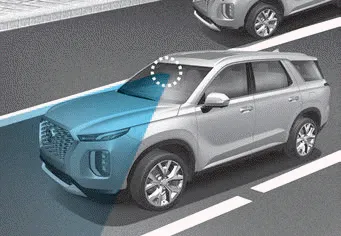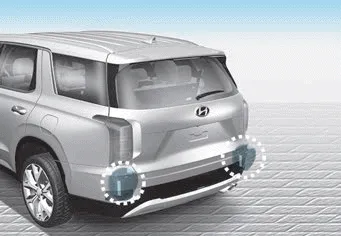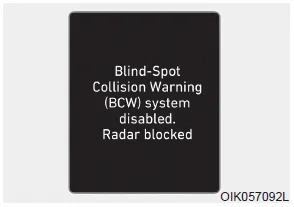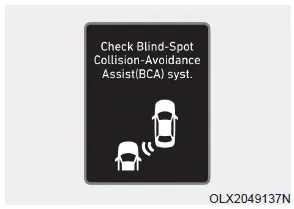Hyundai Palisade (LX2): Blind-Spot Collision Warning/ Blind-Spot Collision-Avoidance Assist / Detecting Sensor (Camera and Radar)

â– Front camera

â– Rear radar
Front camera
The front camera function as a sensor detecting the lane. If the sensor is covered with snow, rain or foreign substance, the system may temporarily be canceled and not work properly. Always keep the sensor clean.
Refer to Lane Keeping Assist (LKA) System for cautions for the front camera sensor.
Rear radar
The rear radars are located inside the rear bumper for detecting the side and rear areas. Always keep the rear bumper clean for proper operation of the system.
NOTICE
- The system may not work properly when the bumper has been damaged, or if the rear bumper has been replaced or repaired.
- The sensing range differs somewhat according to the width of the road. When the road is narrow, the system may detect other vehicles in the next lane.
- The system may turn off if interfered by strong electromagnetic waves.
- Always keep the sensors clean.
- NEVER disassemble the sensor component or apply any impact on the sensor component.
- Be careful not to apply unnecessary force on the radar sensor or sensor cover. If the sensor is forcibly moved out of proper alignment, the system may not operate correctly. In this case, a warning message may not be displayed. Have the vehicle inspected by an authorized HYUNDAI dealer.
- Do not apply foreign objects such as a bumper sticker or a bumper guard near the radar sensor or apply paint to the sensor area. Doing so may adversely affect the performance of the sensor.
- NEVER install any accessories or stickers on the front windshield, or tint the front windshield.
- Pay extreme caution to keep the camera sensor dry.
- NEVER place any reflective objects (i.e. white paper, mirror) over the crash pad. Any light reflection may prevent the system from functioning properly.
Warning message

Blind-Spot Collision Warning (BCW) system disabled. Radar blocked
This warning message may appear When:
- One or both of the sensors on the
rear bumper is blocked by dirt or
snow or a foreign object.
- Driving in rural areas where the
sensor does not detect another
vehicle for an extended period of
time.
- When there is inclement weather
such as heavy snow or rain.
If any of these conditions occur, the light on the BCW/BCA switch and the system will turn off automatically.
When the BCW canceled warning message is displayed in the cluster, check to make sure that the rear bumper is free from any dirt or snow in the areas where the sensor is located. Remove any dirt, snow, or foreign material that could interfere with the radar sensors.
After any dirt or debris is removed, the system should operate normally after about 10 minutes of driving the vehicle.
If the system still does not operate normally have your vehicle inspected by an authorized HYUNDAI dealer.
Information
Turn off the BCW, BCA and RCCW system when a trailer or carrier is installed.
- Press the BCW/BCA switch (the
indicator on the switch will turn off)
- Deactivate the RCCW system by
deselecting
'User Settings → Driver Assistance
→ Parking Safety → Rear Cross-
Traffic Collision Warning' (if
equipped)

Check Blind-Spot Collision Warning (BCW) system
If there is a problem with the BCW system, a warning message will appear and the light on the switch will turn off. The system will turn off automatically. BCA will not operate also if the BCW system turns off due to malfunction. Have your vehicle inspected by an authorized HYUNDAI dealer.

Check Blind-Spot Collision- Avoidance Assist (BCA) system
If there is a problem with the BCA system, a warning message will appear. The system will turn off automatically. BCW will still operate even if the BCA system turns off due to malfunction. Have your vehicle inspected by an authorized HYUNDAI dealer to use BCA system.
Blind-Spot Collision Warning (BCW) system First stage alert If a vehicle is detected within the boundary of the system, a warning light will illuminate on the outer side view mirror and the head up display (if equipped).
The driver must be cautious in the below situations because the system may not detect other vehicles or objects in certain circumstances: When a trailer or carrier is installed.
Other information:
Hyundai Palisade (LX2) 2020-2025 Service Manual: Evaporator Temperature Sensor
Description and operation Description The evaporator temperature sensor will detect the evaporator core temperature and interrupt compressor relay power in order to prevent evaporator from freezing by excessive cooling. Repair procedures Inspection 1.
Hyundai Palisade (LX2) 2020-2025 Service Manual: Repair procedures
Variant Coding When you need variant coding: – Replace Front View Camera with a new one ※ EOL Variant Coding and calibration required for new replacement Front View Camera Variant Coding
Categories
- Manuals Home
- Hyundai Palisade Owners Manual
- Hyundai Palisade Service Manual
- Rear Heater Unit
- Emergency liftgate safety release
- Scheduled maintenance services
- New on site
- Most important about car
